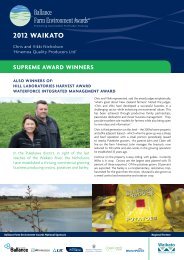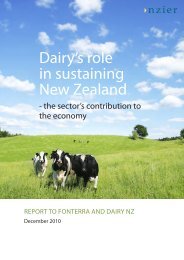NZIER report on compensation for transmission infrastructure
NZIER report on compensation for transmission infrastructure
NZIER report on compensation for transmission infrastructure
Create successful ePaper yourself
Turn your PDF publications into a flip-book with our unique Google optimized e-Paper software.
2.3.1 Estimated easement costs and efficiency<br />
If the cost of an easement is under-stated, and acquired at that cost, then an<br />
easement may be c<strong>on</strong>structed when it is the more expensive opti<strong>on</strong> <strong>for</strong> transmitting<br />
electricity. This would create a net loss or “negative surplus” <strong>for</strong> society at large (the<br />
true costs are greater than the cost of the next best alternative, see „net loss from<br />
easements‟ in Figure 1). In these cases the underestimated porti<strong>on</strong> of easement<br />
costs is borne by landowners. An easement should be created <strong>on</strong>ly if it is the<br />
cheapest and hence most efficient alternative (the sloping line is beneath the flat line<br />
in Figure 1).<br />
Transpower may be faced with, <strong>for</strong> example, the opti<strong>on</strong> of running lines over land that<br />
is predominantly used <strong>for</strong> dairy farming or alternatively a l<strong>on</strong>ger route over land<br />
mainly used to graze sheep (as discussed in secti<strong>on</strong> 4.2, transmissi<strong>on</strong> <strong>infrastructure</strong><br />
imposes significantly higher costs <strong>on</strong> dairy relative to sheep farms). If the additi<strong>on</strong>al<br />
costs imposed <strong>on</strong> dairy relative to sheep farmers from transmissi<strong>on</strong> <strong>infrastructure</strong> are<br />
not c<strong>on</strong>sidered properly then the shorter route may appear to be the cheaper opti<strong>on</strong>.<br />
This would create a net loss.<br />
The full costs imposed <strong>on</strong> the landowners as well as <strong>on</strong> Transpower in both<br />
situati<strong>on</strong>s need to be c<strong>on</strong>sidered when choosing the appropriate route. It may be<br />
cheaper <strong>for</strong> Transpower to run lines the shorter distance over dairy farm-land, yet this<br />
opti<strong>on</strong> would impose greater total costs when the costs imposed <strong>on</strong> dairy landowners<br />
are included in the calculati<strong>on</strong>.<br />
2.3.2 Splitting the surplus efficiently<br />
In theory, compensati<strong>on</strong> equal to the costs imposed <strong>on</strong> the landowner from an<br />
easement would be efficient, as would compensati<strong>on</strong> slightly less than the cost of the<br />
next best alternative to Transpower. If Transpower is required to transfer the full<br />
surplus created by a given easement to the landowner, however, then it will be<br />
indifferent between creating that easement and alternatives. Thus, an alternative less<br />
efficient route may be the outcome if too much of the easement surplus is required to<br />
be paid to landowners.<br />
For purpose of illustrati<strong>on</strong>, c<strong>on</strong>sider a hypothetical example where Transpower has<br />
the opti<strong>on</strong> of running lines over farmland or over a l<strong>on</strong>ger route beside a public road.<br />
The route over farmland would be $50 milli<strong>on</strong> cheaper than the alternative,<br />
c<strong>on</strong>sidering fully the costs of easements. If Transpower are required to pay the entire<br />
$50 milli<strong>on</strong> surplus to landowners then it would be indifferent between choosing<br />
either route and may choose the less efficient opti<strong>on</strong>.<br />
For efficiency purposes compensati<strong>on</strong> must be somewhere between the costs<br />
imposed <strong>on</strong> the landowner from the easement, and slightly less than the next best<br />
alternative facing Transpower. Legally Transpower is required to compensate<br />
landowners an amount equal to the cost of the easement. This would still be efficient<br />
if easements are accurately priced. The opti<strong>on</strong> of compulsory purchase, asymmetric<br />
<str<strong>on</strong>g>NZIER</str<strong>on</strong>g> – Compensati<strong>on</strong> <strong>for</strong> transmissi<strong>on</strong> <strong>infrastructure</strong> 13
















